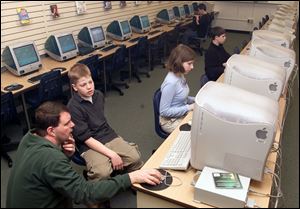
Plan to end web resource rattles school librarians
3/30/2001
Librarian Walt Connolly helps sixth grader Tyler McMaster get on the Internet at Sylvania's Arbor Hills Junior High while seventh grader Janice Pisello and sixth graders Matt Slattery and Ben Ward work at computers, in background.
A free online research service used in all school libraries in Ohio is on the budget chopping block, and school librarians aren't happy about it.
The Infohio Online Electronic Resource provides schools with Encyclopedia Britannica, 217 magazines and newspapers, and other services including a biography series. It can be found on every Internet-connected school computer in Ohio.
Governor Taft's budget calls for eliminating the service to save $1.7 million over two years. School librarians say the move is bad economics, and will throw districts with limited resources onto the mercies of the Internet without access to a controlled educational database.
“The kids have gotten used to using it. Now you're going to say to the kids, `I'm sorry, it's gone,'” said Peggy Rabideau, the media services director for Sylvania public schools. “It's our job to teach kids how to find the information.”
Mrs. Rabideau has written letters of protest to her legislators in an effort to have the program restored.
At Arbor Hills Junior High School, Librarian Walt Connolly said Infohio is one of four controlled databases that children use for their research. The other databases are paid for from Sylvania's budget.
One pupil working in the library yesterday was researching the late Jacqueline Kennedy Onassis.
Matthew Slattery, 12, said he already had found biographical details on the Internet about Mrs. Onassis, from which he made notes that he then typed into a word-processing document. The final step will be to locate a picture of Mrs. Onassis and paste that into his report, assigned for Women's History Month.
Mr. Connolly said that picture likely will come from the encyclopedia provided by Infohio.
“It has a lot more information than books because there's a lot of web sites about her,” Matthew said of the Internet. “I usually come here during study hall and then sometimes I come after school.”
Although schools still will have the Internet if the online electronic resource is eliminated, school librarians said wide-open use of the Internet by students is not very productive.
Cynthia Hustead, project assistant for Infohio, said the online electronic resource is one of three major state-funded databases. Two others are operated by the state's public libraries and by universities.
“It takes four years to get teachers and students acclimated to use the services, and then to have them totally wiped out devastates all teachers,” Ms. Hustead said.
Money for the service was included in the Department of Education's budget submitted to Governor Taft, but was not included by the governor.
A spokesman for the governor declined comment on the issue.
Districts will have alternatives if Infohio is eliminated, but it still will be a loss, librarians said. For example, Sylvania subscribes to Electric Library, a database even more voluminous than the online electronic resource, at a cost of $1,400 per school.
Mr. Connolly said smaller districts will be harder hit than Sylvania if they cannot afford to replace Infohio.
Ms. Hustead and others said the state is under pressure to channel as much money as possible into a school-funding solution that will satisfy the Ohio Supreme Court, which ruled that the current funding system is inadequate and unconstitutional.
Carly Glick, a spokeswoman for Ohio SchoolNet, said the agency is trying to make the case that for only 28 cents a pupil, the online electronic resource contributes to school equity at a minimal cost.